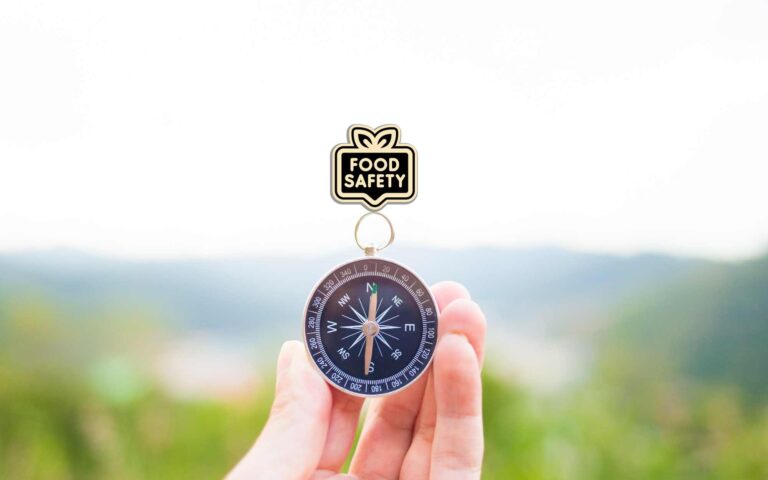Food contamination poses serious risks—not only to public health but also to a food business’s reputation. Illness, injury, or even death can result from unsafe food, and the consequences for a business found responsible can be devastating.
While many believe there are only three types of contamination, there are actually four key types that every food handler must understand. Knowing them—and how to prevent them—is essential to keeping your customers safe and protecting your brand.
The Four Types of Food Contamination
Every food business is legally and ethically responsible for preventing contamination of their food products from any of the four main types of food contamination enumerated below:
- Chemical Contamination
- Microbial Contamination
- Physical Contamination
- Allergenic Contamination
Let’s take a closer look at each one and how to manage the risks.
- Chemical Contamination
Chemical contamination happens when harmful chemicals get into food. This is one of the most preventable types of contamination, but yet it’s surprisingly common.
Cleaning products, pesticides, and even food-grade chemicals can all pose chemical contamination risks if not handled properly. For example:
- Preparing food on a surface with leftover cleaning residue.
- Spraying disinfectants near uncovered food.
- Using ingredients grown near areas treated with pesticides or fertilizers.
To reduce the risk of chemical contamination:
- Store chemicals well away from food and food prep areas.
- Always follow manufacturer guidelines when using chemicals.
- Cover all food before cleaning begins.
- Use reputable suppliers who follow strict food safety practices.
- Microbial Contamination
This is the most common and potentially the most dangerous type of contamination. Microbial contamination occurs when food becomes infected with microorganisms such as bacteria, viruses, fungi, moulds, or the toxins they produce.
Some common scenarios include:
- Undercooked chicken harboring Campylobacter.
- Salmonella transferring from animal intestines during slaughter.
- Cross-contamination between raw and ready-to-eat foods.
- Shellfish that have consumed toxin-producing organisms.
To prevent microbial contamination:
- Maintain high standards of personal hygiene and never handle food while sick.
- Keep raw and ready-to-eat foods separate throughout the entire food handling process.
- Wash all raw fruits and vegetables thoroughly.
- Implement a strong pest control program and regularly check for signs of infestation.
- Physical Contamination
Physical contamination happens when foreign objects end up in food. These can enter the food at any stage from production to plating and may result in serious injury, such as choking or broken teeth.
Common physical contaminants include:
- Hair, jewellery, stones, and bones.
- Plastic, fabric, or parts from broken kitchen equipment.
- Pest droppings or body parts.
- Flaking paint, metal screws, or other debris from damaged facilities.
Worse yet, some physical contaminants can also carry harmful bacteria.
How to prevent physical contamination:
- Replace damaged or worn-out equipment immediately.
- Report equipment faults or structural issues without delay.
- Enforce strict dress code rules like removing jewellery and wearing hairnets.
- Keep a proactive pest control system in place.
- Allergenic Contamination
Allergenic contamination occurs when a food allergen unintentionally comes into contact with another food product. This is especially dangerous, as even trace amounts of an allergen can cause life-threatening reactions.
For example:
- Using the same knife to cut regular and gluten-free bread.
- Storing pasta in a container that previously held peanuts.
There are 9 major allergens recognized by law, in the United States, known as the big nine (9) and they include milk, eggs, fish (e.g., bass, flounder, cod), Crustacean shellfish (e.g., crab, lobster, shrimp), tree nuts (e.g., almonds, walnuts, pecans), peanuts, wheat, soybeans, sesame (added as the 9th major allergen under the FASTER Act, effective January 1, 2023).
There are 14 major allergens recognized in the European Union (EU) and Canada by law, includes cereals containing gluten (e.g., wheat, rye, barley, oats, spelt, and their hybridized strains), crustaceans (e.g., crab, lobster, shrimp), celery, peanuts, tree nuts, eggs, milk, fish, shellfish, mustard, soy, sesame, sulphur dioxide and sulphites (at concentrations of more than 10 mg/kg or 10 mg/L), lupin, and Molluscs
(e.g., clams, mussels, oysters, squid) as per EU Regulation (EU) No 1169/2011 and Canada’s Food and Drug Regulations.
To avoid allergenic contamination:
- Source ingredients from trusted suppliers who follow allergen safety protocols.
- Use separate equipment, utensils, cloths, and preparation areas for allergen-containing foods.
- Store allergenic and non-allergenic foods separately.
- Deep-clean all surfaces and tools after handling allergenic ingredients.
In Summary
Every type of food raw or ready-to-eat is at risk of one or more types of contamination. Whether chemical, microbial, physical, or allergenic, contamination can lead to serious consequences, including foodborne illness, injury, or death.
But with the right safety practices, these risks can be managed and minimized. By staying alert, following good hygiene and sanitation protocols, and training your team properly, you help ensure that your food is safe and your business is trusted.
Watch our video series on our YouTube platform for more detailed and visual presentation of each of the food safety hazards briefly discussed here. Feel free to leave a comment and ask any question to better understand the topic discussed.
Reach out to Fresh Group Food Safety And Quality Consulting for any inquiries related to food quality and safety.




